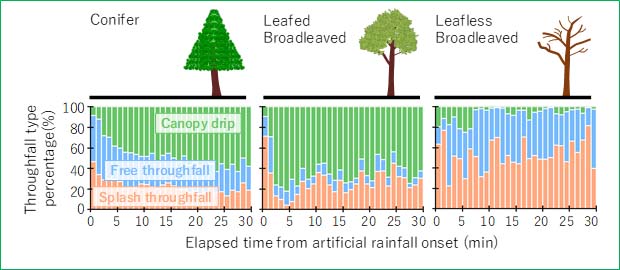Home > Research > Research Results > Research Results 2019 > Rainfall differences in forests as revealed by drop size
Update:June 26, 2019
Main content starts here.
Rainfall differences in forests as revealed by drop size
| Article title |
Throughfall partitioning by trees |
|---|---|
| Author (affiliation) |
Delphis F. Levia* (a), Kazuki Nanko* (b), Hiromasa Amasaki (c), Thomas W. Giambelluca (d), Norifumi Hotta (e), Shin’ichi Iida (b), Ryan G. Mudd (d), Michael A. Nullet (d), Naoki Sakai (f), Yoshinori Shinohara (g), Xinchao Sun (h), Masakazu Suzuki (e), Nobuaki Tanaka (i), Chatchai Tantasirin (j), Kozo Yamada (c, k) (a) University of Delaware, Newark, Delaware, USA. (b) Department of Disaster Prevention, Meteorology and Hydrology, FFPRI, Tsukuba, Ibaraki, Japan. (c) Kyoto University of Art and Design, Kyoto, Japan. (d) University of Hawai‘i at Mānoa, Honolulu, HI, USA. (e) The University of Tokyo, Tokyo, Japan. (f) National Research Institute for Earth Science and Disaster Resilience, Tsukuba, Ibaraki, Japan. (g) University of Miyazaki, Miyazaki, Japan. (h) Tianjin University, Tianjin, China. (i) The University of Tokyo, Seto, Aichi, Japan. (j) Kasetsart University, Bangkok, Thailand. (k) Hanatoyo Landscape Co., Ltd., Kyoto, Japan. * These authors contributed equally to this work; we make no distinction between the first and second authors. |
| Publication Journal |
Hydrological Processes, March 2019 DOI:10.1002/hyp.13432( External link ) |
| Content introduction |
Rainfall wets the forest crown, and the majority (50%–80%) of the rainwater then flows to the ground as throughfall and permeates to the soil surface. Depending on how the water falls, throughfall can be categorized into three types: uninhibited by leaves and branches (free throughfall), in large drops after accumulating on leaves and branches (canopy drip), and in small drops after the rain splash by leaves and branches (splash throughfall). Although the total volume of throughfall can be measured using rain gauges and containers such as buckets, we were previously unable to determine the amount in each throughfall type. Using the different drop sizes of the three throughfall types, we developed a method to determine the volume in each component. For this, we analyzed drop data of more than 100 million throughfall records collected from 12 tree species in Japan, the United States, and Thailand, which were simultaneously collected inside and outside forests. Our results showed that throughfall in leafed trees comprises more than half of canopy drip. Moreover, the relative percentage of canopy drip increased in the order of leafless broadleaved, conifer, and leafed broadleaved trees. Further, the relative percentage of splash throughfall was higher in conifer than in broadleaved trees. This indicates that the throughfall differs between conifers and broadleaved trees. The amount of large raindrops in throughfall influences decomposition of the fallen leaves, soil erosion, and rainwater infiltration. Using the developed method, we aim to clarify differences in water movement between a conifer and broadleaved forests. In addition, we aim to contribute to the development of forest management technologies to better utilize groundwater recharge and surface soil retention functions.
Figure. Component composition of throughfall based on the drop size and differences in percentage among the tree groups. |
Copyright © Forest Research and Management Organization. All rights reserved.

